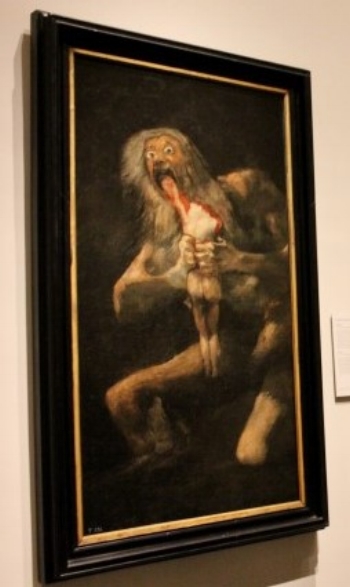People seem to give one opinion of Madrid: they love it! The basis of each opinion varies: some love the food, some the wine, some the people, some even like the bullfights! For me, Madrid offered a profound richness of art…although the food, wine, and people were great! Running a meeting in Madrid, I arrived early to adjust to the time change, landing midday. I headed right into the city to the Paseo del Prado, a beautiful tree- and fountain-lined boulevard, leading me and a friend to the Prado.
Nearly 200 years old and housing a collection of 17000 items, the Prado could be overwhelming (like Paris’s Louvre and New York’s Metropolitan)…but I had a focused list for my short visit, because unlike the all-encompassing collections of the other museums, the Prado focuses on artists, not all art.
© Museo Nacional del Prado
I started with the Italian Fra Angelico Annunciation from the early Fifteenth Century. Like many other treatments of the subject, it is beautiful, holy, devout; but he adds the fall of Adam and Eve to the left of the main image, revealing what the Prado calls, “The damnation and salvation of Humanity.”
Then I turned naturally to the Spanish painters: El Greco, Velazquez, Goya, and Picasso.
© Museo Nacional del Prado
I was surprised to love several of the El Greco paintings—especially the portraits, which seemed to introduce me to real people whom I felt I could know…even though they lived 4-to-5 centuries ago. The famous Nobleman with his Hand on his Chest is an unnamed gentleman whose identity pours from the canvas: he meets the viewer with a confident gaze and with his hand seeming to offer a pure heart. The nobility of the gentleman is plain, and so is his humanity.
© Museo Nacional del Prado
The Prado boasts the largest collection of Velazquez, including portraits, editorial pieces (religious or mythic), even the bizarre. The most intriguing piece in the collection is Las Meninas, a tricky self-portrait/portrait/commentary. Velazquez appears to be painting the royal couple—visible in the mirror near the center of the image—and instead presents himself, the princess Margaret Theresa and her entourage. Considerable in its size (10.5’x9’), the painting is provocative of the relationship among artist, art, and viewer. Velazquez looks out of the shadows at the royal couple and at us, the viewers: he is seeing us seeing him and I was well aware of sharing the position of the royalty, watched and watcher.
© Museo Nacional del Prado
I moved on to see the paintings of Francisco Goya, which were more impassioned than El Greco’s or Velasquez’s. His The Third of May, 1808 is stunning: the victims are terrified yet visibly innocent, many covering their faces or holding their heads in fear; the central victim is brightly lighted and offers himself in a glowing Christ-like posture of crucifixion; conversely, the murderers are hunched and hidden in shadow. It is a strong political statement against the tyranny of Napoleon, whose troops punished an earlier revolt by killing hundreds of rebels and innocent bystanders alike.
© Museo Nacional del Prado
Then I came to Goya’s Black Paintings, 14 paintings discovered after his death as mural decorations in his home. They were displayed in continual galleries, where I tried to appreciate the concept of someone’s finding all these paintings in Goya’s home, images ranging from fear and rage to tranquility. Most famous among them is Saturn, a terrifying and grotesque image, especially as home décor! Although he left no explanations of his intentions, Goya, in his mid-70s, must have been raging or fearing or regretting something powerful to compose his horrific Saturn.
© Museo Nacional del Prado
Then I moved from Spanish to Dutch: Bosch’s Garden of Earthly Delights may be the most famous painting in the Prado, and it was way more freakish than I had anticipated. Bosch had no predecessor for his creation of bizarre, freakish, scary creatures all across the landscape doing all kinds of bizarre things. Had he painted in the 1950s, we’d assume that he was using drugs. The painting was startling and overflowing with tiny, bizarre details, all adding up to the story of the creation, downfall, and punishment of Man.
© Museo Nacional del Prado
I was equally startled to see Pieter Breughel’s, Triumph of Death. It was as scary and freakish as the Bosch, but Breughel had had Bosch as a trailblazer. In his Triumph, Breughel shows no downfall, but places everyone at the threat of Death, a skeletal army led by a sickle-wielding skeleton on horseback. He constructed this view of the world in umber, giving the entire scene a hellish feel.
© Museo Nacional Centro de Arte Reina Sofía
For our final view of Madrid’s artistic treasures, we ran four blocks to the Reina Sofia Museum to see Picasso’s, Guernica before the museum closed. I am not usually a Picasso fan, but Guernica is awesome. The size (11.5’x25.5’), the stark lack of color, the confusion of overlapping shapes, the numerous open mouths crying out (especially the Cabeza de Caballo)…it was awesome. It portrays the result of violence: pure suffering and agony…it shows nothing of the planes or bombs or fires that prompted the image; the only sign of violence is a broken sword in a dismembered hand at bottom center. Yet, its antiwar meaning is powerfully clear.
As evening came on, we went to an old section of the city to the Mercado San Miguel to feast willy-nilly on tapas, manchego, serrano ham, and Spanish wines—clean, fresh, and fragrant; but impressions of the art dominated our senses.








